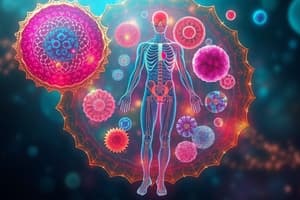Podcast
Questions and Answers
What is histology?
What is histology?
The study of animal and plant tissues.
Stem cells can divide and create to another type of cells, such as ______ cells.
Stem cells can divide and create to another type of cells, such as ______ cells.
bone
What are the three types of bone cells?
What are the three types of bone cells?
- Osteoclasts (correct)
- Osteocytes (correct)
- Osteon
- Osteoblasts (correct)
- Chondrocytes
Red blood cells are the only type of blood cells in the human body.
Red blood cells are the only type of blood cells in the human body.
What are muscle cells also known as?
What are muscle cells also known as?
What is the primary cell that makes cartilage?
What is the primary cell that makes cartilage?
Which of the following are types of epithelial tissues based on cell shape?
Which of the following are types of epithelial tissues based on cell shape?
Which tissue types are found in animals?
Which tissue types are found in animals?
The inner wall of the stomach is lined by ______ epithelial cells for absorption.
The inner wall of the stomach is lined by ______ epithelial cells for absorption.
What are the two main types of sex cells?
What are the two main types of sex cells?
Flashcards are hidden until you start studying
Study Notes
Cell Development and Differentiation
- Cells in multicellular organisms grow, mature, and differentiate into specialized types.
- Over 200 differentiated cell types exist in the human body, forming tissues.
- Tissues consist of groups of similar cells serving a common function.
- Histology is the study of animal and plant tissues, involving thin section preparation and microscopic examination.
Types of Cells in the Human Body
Stem Cells
- Capable of division and differentiation into various cell types (e.g., bone, epithelial).
Bone Cells
- Essential for bone production and repair.
- Types include:
- Osteoclasts: dissolve bone tissue.
- Osteoblasts: create new bone.
- Osteocytes: communicate with other bone cells.
Blood Cells
- Red Blood Cells (RBC): transport oxygen.
- White Blood Cells (WBC): divided into:
- Granulocytes
- Monocytes
- Lymphocytes (subtypes include neutrophils, phagocytic, and basophils, involved in pathogen defense).
- Platelets: aid in blood clotting.
Muscle Cells
- Also called Myocytes; long, tubular cells supporting organ function and peristalsis.
Sex Cells
- Responsible for reproduction through:
- Oogenesis: formation of egg cells.
- Spermatogenesis: formation of sperm cells.
Fat Cells
- Produce and store fats in a clustered arrangement, known as adipose tissues.
Nerve Cells
- Neurons: transmit and relay signals throughout the body, facilitating communication.
Epithelial Cells
- Line surfaces and cavities, playing pivotal roles in communication and protection.
- Types include:
- Epithelium
- Endothelium
- Mesothelium
Cartilage Cells
- Chondrocytes are the primary cells responsible for forming cartilage, residing within lacunae.
Types of Tissues
- Four primary types in animals:
- Epithelial
- Connective
- Muscular
- Nervous
- Organs consist of multiple tissue types, working together for specific functions, like the stomach which contains:
- Columnar epithelial cells for absorption.
- Smooth muscle tissues for peristalsis.
- Nervous tissues for signaling.
- Blood as connective tissue for nutrient transport.
Epithelial Tissues
- Composed of specialized cells organized in one or more layers.
- Categories include:
- Simple Epithelium: single layer.
- Stratified Epithelium: multiple layers.
- Shapes of epithelial cells:
- Squamous: flattened (found in alveoli and capillaries for gas exchange).
- Cuboidal: cube-shaped with larger cytoplasm, facilitating absorption and secretion.
- Pseudostratified: appears stratified but consists of varying cell heights, often found in respiratory pathways.
Connective Tissues
- Characterized by dispersed cells and extensive extracellular matrix (ECM).
- ECM components include:
- Protein fibers (collagen, elastic, reticular).
- Ground substances, predominantly secreted by connective tissue cells.
- Types of ECM:
- Solid (bone)
- Soft (connective tissues)
- Liquid (blood)
- Functions include:
- Protection
- Cushioning
- Fat storage
- Nutrient and waste transport
- Maintenance of structure.
Studying That Suits You
Use AI to generate personalized quizzes and flashcards to suit your learning preferences.




